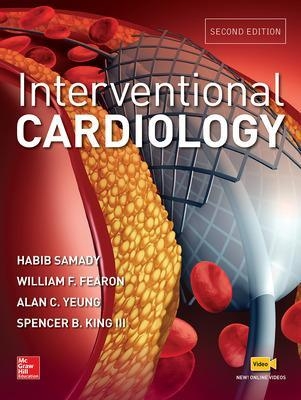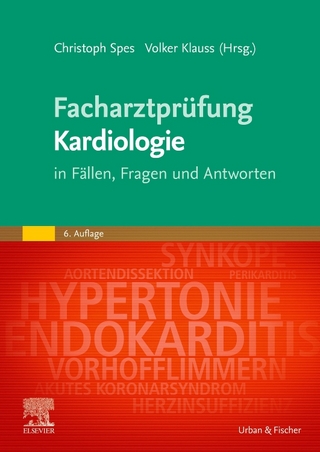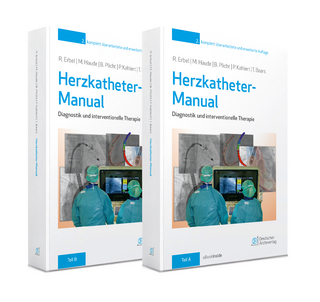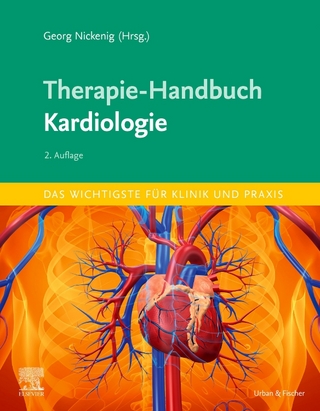
Interventional Cardiology, Second Edition
McGraw-Hill Professional (Verlag)
978-0-07-182036-3 (ISBN)
Filling a crucial gap in procedural knowledge, this groundbreaking reference was the first to focus on interventional cardiovascular procedures. Interventional Cardiology, Second Edition includes a completely updated section on procedures, as well as chapters on the necessary scientific foundation, to which specialists will refer every day in their clinical practice. In addition, each procedural chapter is enhanced by valuable tips and pitfalls from an internationally recognized group of experts.
The comprehensive coverage of this groundbreaking resource is highly accessible, thanks to a well-organized full-color format that synthesizes important information and provides a consistent template in describing each procedure. Throughout the book, charts and tables help to summarize key concepts and can serve as the basis for a detailed overview.
FEATURES:
•NEW to this edition: Multiple-choice questions (with answers) at the end of most chapters
•21 NEW CHAPTERS, including History of Interventional Cardiology, Publishing Interventional Cardiology Research, Web-Based Learning, Medical Simulation in Interventional Cardiology, Emerging Clinical Applications of Physiologic and Intravascular Imaging Tools, An Overview of MitraClip Procedure, Cell Therapy for Cardiovascular Disease, and more
•Edited by some of the foremost experts in the field, and featuring contributions from key opinion leaders in interventional cardiology
•Top-to-bottom coverage of the latest interventional cardiology techniques
•Valuable perspectives on avoiding and properly managing complications
•Up-to-date information on devices
•Numerous high-quality full-color images and figures throughout
•High-yield content makes it valuable for board review
•More than 1,500 illustrations, including more than 600 full-color photographs.
Alan Yeung is the Co-Founder, President, and CEO of Where2Net, a provider of multi-channel software development tools and web applications. Dr. Yeung regularly speaks about wireless technologies and innovations at conference and seminars and is a guest lecturer at San Jose State University, where he teaches courses on Wireless Computing. Dr. Yeung received his MBA from University of California at Berkeley, his Ph.D. and MSChE from Stanford University, and a BSChE degree from University of Wisconsin. Spencer B. King, III, MD Director, Interventional Cardiology Emory University School of Medicine Atlanta, GA
Part 1. Knowledge Foundation
Section 1. Anatomy for Interventional Cardiology
1. Coronary Artery Anatomy for the Interventionalist, add some bypass anatomy?
2. Cardiac Chamber Anatomy (emphasize atrial septum and appendage)
2’. Valve Anatomy (emphasize aortic and mitral)
3. Peripheral Anatomy for the Interventionalist add radial (upper arm) anatomy Should we add carotid?
Section 2. Physiology
4. The Coronary Circulation, emphasize FFR based concept
5. Physiological Evaluation of Renal Artery Stenosis: A Hemodynamic Approach
5’. Sympathetic nervous system physiology (enphasize renal)
Section 3. Pathophysiology
6. Valvular Pathophysiology
7. Arterial Disease Separate Coronary atherosclerosis from Arterial Disease
8. Ventricular Pathophysiology
Part 2. Equipment: Construction and Performance
9. Equipment for Percutaneous Coronary Intervention
10. Design and Construction of Stents
11. Adjunctive Devices: Atherectomy, Thrombectomy, Embolic Protections, IUVS, Doppler, and Pressure Wires
11”. Aortic valvuloplasty equipment
11’’: TAVR Equipment
11’’’: ?Renal Dernervation equipment
11’’’’ Closure devices
11’’’’’Equiptment for structural heart disease interventions (ASD PFO etc) --This may precede TAVI, renal etc
Part 3. Principles and Catheter Laboratory Equipment
12. X-Ray Cinefluorographic Systems
13. Operational Radiation Management for Patients and Staff
14.
15. X-Ray Computed Tomography and Magnetic Resonance Imaging of the Coronary Arteries
16. Intracardiac Echocardiography, OTC and FFR in the Catheterization Laboratory
17. Cardiac Catheterization Laboratory Physiologic Recorders
18. Digital Image Formats and Archiving Practices
Part 4. Pharmacology Major update in content
19. Antithrombin Therapies
20. Antiplatelet Therapies in Contemporary Percutaneous Coronary Intervention
21. Thrombolytic Therapy
22. Radiographic Contrast Media
23. Renal Complications of Contrast Media
24. Patient Sedation in the Cardiovascular Catheterization Laboratory
Part 5. Procedures
25. Diagnostic Procedures: Special Considerations
25’ Radial Approach
26. Diagnostic Procedures: Peripheral Angiography
27. Adjunctive Diagnostic Techniques
28. Coronary Guidewire Manipulation
29. Coronary Balloon Angioplasty
30. Coronary Stenting, Bare Metal Stents, and Drug-Eluting Stents plus Bioabsorbable stents
30’: Drug eluting balloon
31. Rotational Atherectomy: Concepts and Practice
32” Instent restenosis
33. Basic Wire-Handling Strategies for Chronic Total Occlusion
34. Percutaneous Intervention in Chronic Total Coronary Occlusions
36. Distal Embolic Protection Devices
37. Intervention in Venous and Arterial Grafts
38. Special Considerations: Acute Myocardial Infarction
39. Complex Lesion Intervention: Bifurcation, Left Main Coronary Artery, and Ostial Lesions
40. Special Considerations: Small Vessel and Diffuse Disease
41. Special Patient Subsets: Diabetic and Elderly
42. Inoue-Balloon Mitral Valvuloplasty
43. Aortic Valvuloplasty and Future Solutions to Aortic Valve Disease
44. Two TAVR techniques
44. Balloon Pulmonary Valvuloplasty
44’Mitral clip
44’’Atrial appendage closure
45. Percutaneous Closure of Atrial Septal Defect and Patent Foramen Ovale
46. Alcohol Septal Ablation for Obstructive Hypertrophic Cardiomyopathy
47. Coronary Vein Device Insertion
48. Device Retrieval Systems
49. Percutaneous Treatment of Coronary Artery Fistulas
50. Renal Artery Angioplasty and Stenting
50’: Renal denervation
51. Iliac Angioplasty and Stenting
52. Endovascular Abdominal Aortic Aneurysm Repair
53. Carotid and Vertebral Artery Intervention
Part 6. Complications and Management More case based
54. Risk Stratification in Interventional Cardiology
55. Acute Threatened Coronary Closure
56. Subacute Closure
57. Coronary Artery Perforation
58. Embolization and No-Reflow During Percutaneous Coronary Intervention
59. Emergency Surgery
60. Complications of Peripheral Procedures
60’ Emergency resuscitation measures
Part 7. Medical Management of Risk Factors
61. Lipid-Lowering Therapy and the Interventional Cardiologist
62. Hypertension
63. Diabetes and Cardiovascular Disease
64. Nontraditional Risk Factors for Atherosclerosis
Part 7’ Procedure selection (AUC and the “Heart Team”)
64’ Appropriateness criteria for coronary revascularization
64’’ Appropriateness criteria for other procedures if there are any
Part 8. Preclinical and Clinical Trials
65. Preclinical Laboratory Functions
66. The Core Laboratory: Quantitative Coronary Angiography and Intravascular Ultrasound
67. How to Read Clinical Trials
Part 9. Reimbursement and Hospital Finance
68. Cost-Effectiveness
69. Quality Assurance and Quality Improvement in Interventional Cardiology
69’ ACO
Part 10. Principles of Innovation
70. Innovation and Interventional Cardiology: Looking Back, Thinking Ahead
71. Principles of Innovation: Transforming Clinical Needs into Viable Inventions
71’’’ Regulatory considerations
71’. Web based learning
71’’. Web based clinical care
Index
| Erscheinungsdatum | 29.01.2018 |
|---|---|
| Zusatzinfo | 331 Illustrations |
| Sprache | englisch |
| Maße | 218 x 279 mm |
| Gewicht | 3781 g |
| Themenwelt | Medizin / Pharmazie ► Allgemeines / Lexika |
| Medizin / Pharmazie ► Medizinische Fachgebiete ► Chirurgie | |
| Medizinische Fachgebiete ► Innere Medizin ► Kardiologie / Angiologie | |
| ISBN-10 | 0-07-182036-1 / 0071820361 |
| ISBN-13 | 978-0-07-182036-3 / 9780071820363 |
| Zustand | Neuware |
| Informationen gemäß Produktsicherheitsverordnung (GPSR) | |
| Haben Sie eine Frage zum Produkt? |
aus dem Bereich


